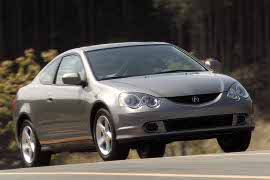ACURA RSX Models/Series Timeline, Specifications & Photos
First production year: 2002
Engines: Gasoline
Body style: Coupé (two-door)
Acura updated its sporty compact model RSX for the 2005 and 2006 model years, trying to raise the car's sales, but in the end, it decided to completely abandon the model.
The RSX was the end of the famous Integra nameplate on the market. While it was still based on the same platform as the Honda Civic Coupe, it was built as a more luxurious version for it. Unfortunately, it failed to provide the comfortable ride required by a premium vehicle, and since it was heavier than its sibling, it was not the first choice for a teenager. Nevertheless, it was also costlier. Other than that, it was a highly appreciated vehicle by its owners.
The 2005 model year came with a slightly updated front fascia, where the headlights didn't sport the same double-curve on their lower side. Ditching that idea, which didn't work very well in the first place, making room for a straight line that pleased the customers more. Another improvement was on the lower part of the bumper, which got redesigned grille and side scoops. To upgrade the car's side view, Acura installed standard 17" light-alloy wheels on the Type S version. Finally, at the back, the taillights matched the headlights' design, with a straight line at their bottom instead of that double-curved line.
Inside, the RSX featured the same minimalist interior design as on the non-facelifted version. Yet, the car still boasted sports seats on the options list. Moreover, leather upholstery was also available. In addition, customers could opt for a sunroof. In addition, the HVAC unit was available with automatic climate control.
The RSX was powered by a 2.0-liter engine fitted with the already famous VTEC variable valve timing, which was paired with either a five-speed manual or a five-speed automatic.
The RSX replaced the Acura Integra in the Japanese manufacturer lineup, and it was a massive evolution over its predecessor.
Available with a choice of two engines, the RSX impressed everyone. It wasn't heavier than its predecessor, and it offered better performances. The only downside was the strut-type front suspension instead of the double-wishbone system used by the Integra. It was a joyful vehicle that became a cult car, and most of them were modified.
While its predecessor was criticized for the four-round small headlamps, the RSX recovered with the introduction of a set of big lights up-front, with clear lenses. The raked A-pillars and the short roof ended into a sloped liftgate made the car looks smaller than it was. A wing on the back was fitted as standard for the RSX TypeS version.
The interior was vastly improved over the previous generation with better materials and up-scale finishes. Depending on the trim level, it featured bucket or sport-bucket seats. A thick steering wheel and an instrument panel with white dials completed the image of a sporty little car. There was hardly any room in the back, but it was enough for two kids or for someone who just needed a short trip.
Under the hood, the base version featured a 1.6-liter VTEC engine paired with a 5-speed manual or a 5-speed automatic. Acura offered the TypeS version exclusively with a 6-speed manual and a limited-slip differential.
The fourth generation of the Acura RSX Coupe was introduced in 2002 and it was offered for the U.S. market with enough performance and luxury items to become a desirable small little sports car.
The Acura RSX was the direct successor of the Honda/Acura Integra Type R. It was considered the fourth generation of the Acura, even though that it didn't have the “Integra” name included. Unlike its predecessors, the RSX offered more comfort and features and it was a mix of premium touch and sporty behavior, more than just a sports coupe.
Also known as the Integra DC5, the RSX Coupe featured a two-door bodywork only, unlike its predecessors which were offered also with 5-door versions on several markets. An aggressive front styling and an option for a rear wing on the trunk lid made were part of the sporty image.
Inside, the white dials with red needles and sport-bucket seats were definitely a sign that the car was built for a sporty drive. It was built as a 2+2 coupe, but due to the small wheelbase, it was more like a 2-seater with a big shelf in the back.
The RSX featured the same platform as the seventh generation of the Civic. It was the first time when they dropped the double-wishbone suspension in favor of McPherson struts in the front and trailing arm in the rear and that affected the cornering speed in a bad way. The RSX was offered with a choice of two engines, both with 2.0-liter displacement and the standard transmission was a 5-speed manual. After the 2005 facelift, it was introduced a 6-speed manual and a 6-speed automatic.


